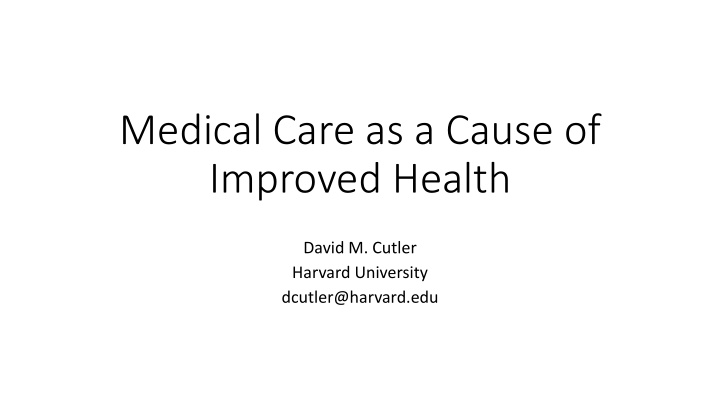



Medical Care as a Cause of Improved Health David M. Cutler Harvard University dcutler@harvard.edu
What matters for health? DHHS S (1980) 49% 49% 41% 41% 11% 11% Unit ited Healt lth Foundatio ion (2 (2016) 25% 25% 60% 60% 15% 15% Park et al al. (2 (2015) 27% 27% 46% 46% 26% 26% McGin innis et al. l. (2002) 40% 40% 50% 50% 10% 10% Hunink k et t al. l. (1997) 50% 50% 7% 7% 43% 43% Ford et al al. (2 (2007) 44% 44% 9% 9% 47% 47% Booske et t al. l. (2010) 30% 30% 50% 50% 20% 20% 0% 10% 20% 30% 40% 50% 60% 70% 80% 90% 100% Behaviors Social Circumstances, Environment, Genetics Medical Care
Biggest difference – cross-section v. time series Health knowledge and technology is the Technology is a lot better now than same everywhere most of difference due then medical care matters more to behaviors and social factors
Expected age at death, by current age 85 83 81 79 77 75 73 71 69 67 65 1949 – 1951 1959 – 1961 1969 – 1971 1979 – 1981 1989 – 1991 1999 – 2001 2015
Change in Life Expectancy by Condition, 1990-2014 Heart Disease Cerebrovascular Disease Trachea, Bronchus, and Lung Breast Colon, rectum, anus Prostate Other cancer Infant Mortality HIV Parkinson's Alzheimer's Accidents Other accidents Other -0.5 0 0.5 1 1.5 2 Years of Life Expectancy
Ischemic heart disease mortality rates per 100,000: Actual vs. simulated in elderly Medicare beneficiaries 1,300 1,200 Treatment effect Mortality Rates per 100,000 1,100 1,000 Risk factor effect 900 Counterfactual (rates per 100,000 at 92 mortality) 800 Treatment Effect only Ischemic Heart Disease mortality (Actual) 700 Treatment + Risk Factor (Total Effect Simulated) 600 1992 1993 1994 1995 1996 1997 1998 1999 2000 2001 2002 2003 2004 2005 2006 2007 2008 2009 Chernew et al., 2015, based on IMPACT model of Ford et al.
Estimated deaths prevented or postponed in the elderly United States population: Treatment effect in elderly Medicare beneficiaries 1992 1993 1994 1995 1996 1997 1998 1999 2000 2001 2002 2003 2004 2005 2006 2007 2008 2009 0 -5,000 Number of deaths prevented or postponed -10,000 -15,000 -20,000 -25,000 Anti-hypertensive treatments (non-IHD cohort) -30,000 Statins + Warfarin (primary prevention in non-IHD cohort) -35,000 IHD ( ICD9 410.XX- 414.XX) hospitalized cohort (Aspirin, Beta-blockers, ACE inhibitors Resuscitation, Primary PCI and CABG) -40,000 Statins + Warfarin (IHD cohort) Ace inhibitors & Beta Blockers (IHD cohort) -45,000
Trends in Risk Factor Control Cardiovascular risk factors (20 years and older): age-sex adjusted to 2009-2010 NHANES 45% 40% 35% 30% Percent 25% 20% 15% 10% 5% 0% NHANES I NHANES II NHANES III 1999-2002 2003-2006 2007-2010 2011-2014 Hypertension (uncontrolled) 41% 29% 23% 20% 17% 15% 14% Hyperlipidemia (uncontrolled) 30% 21% 17% 16% 13% 12% Obese 15% 15% 23% 33% 35% 37% 39% Current Smoker 40% 36% 28% 24% 25% 22% 20% Diabetes (uncontrolled) 6% 10% 10% 12% 10%
My questions 1. How to get people to do what they want? • Take meds, stop smoking, lose weight, avoid addictive substances • How to talk to their doc about $$$ • Not all of this is medical, but some is 2. How to harness innovation of the medical system for good? • Most important areas: Pain; dementia
The importance of pain
Recommend
More recommend